Cite this document
(Euthanasia: Philosophy and the Law Case Study Example | Topics and Well Written Essays - 1250 words - 9, n.d.)
Euthanasia: Philosophy and the Law Case Study Example | Topics and Well Written Essays - 1250 words - 9. https://studentshare.org/philosophy/1784403-euthanasia
Euthanasia: Philosophy and the Law Case Study Example | Topics and Well Written Essays - 1250 words - 9. https://studentshare.org/philosophy/1784403-euthanasia
(Euthanasia: Philosophy and the Law Case Study Example | Topics and Well Written Essays - 1250 Words - 9)
Euthanasia: Philosophy and the Law Case Study Example | Topics and Well Written Essays - 1250 Words - 9. https://studentshare.org/philosophy/1784403-euthanasia.
Euthanasia: Philosophy and the Law Case Study Example | Topics and Well Written Essays - 1250 Words - 9. https://studentshare.org/philosophy/1784403-euthanasia.
“Euthanasia: Philosophy and the Law Case Study Example | Topics and Well Written Essays - 1250 Words - 9”. https://studentshare.org/philosophy/1784403-euthanasia.


